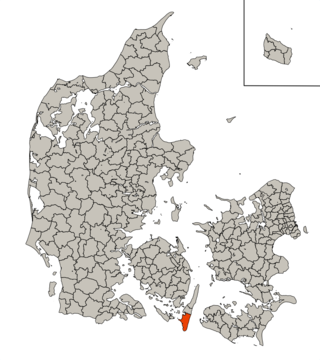
Until 1 January 2007 Sydlangeland Municipality was a municipality in the former Funen County, on the southern parts of the island of Langeland. It also included the inhabited islands of Lindø and Langø, as well as a number of smaller uninhabited islands. The municipality covered an area of 120.82 km2, and had a total population of 4,034 (2006). Its last mayor was Knud Gether, a member of a local political party.
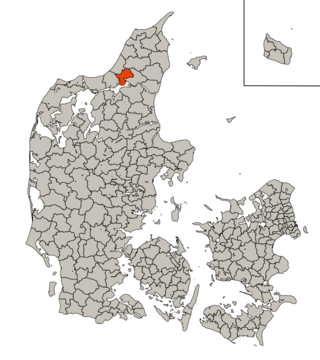
Until January 1, 2007 Aabybro Municipality was a municipality in the former North Jutland County, on the south coast of the North Jutlandic Island, bordering the Limfjord. The municipality covered an area of 170.88 km2, and had a total population of 11,390 (2006). Its last mayor was Ole Lykkegaard Andersen, a member of the Venstre political party.

Tinglev is a town with a population of 2,738 in Aabenraa Municipality in Region of Southern Denmark on the Jutland peninsula in south Denmark. Tinglev is a base for German minority institutions in Southern Jutland, the minority Schleswig Party receiving 18.0% of the town's vote in the municipal elections of 2021.
Amt is a type of administrative division governing a group of municipalities, today only in Germany, but formerly also common in other countries of Northern Europe. Its size and functions differ by country and the term is roughly equivalent to a British or U.S. county.

The Parishes of the Church of Sweden are subdivisions within the Church of Sweden that historically were called socken but nowadays are called församling. Similar units were used for municipal (landskommun) and cadastral purposes until the 20th century.
The Danish Personal Identification number is a national identification number, which is part of the personal information stored in the Civil Registration System.
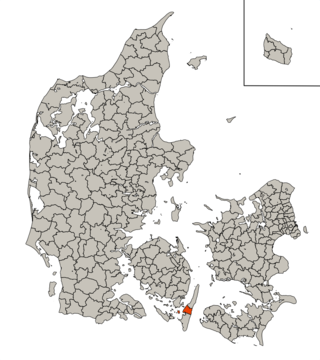
Until January 1, 2007 Rudkøbing Municipality was a municipality in the former Funen County, on the central parts of the island of Langeland. It also included the islands of Strynø, Strynø Kalv and a number of small uninhabited islands. The municipality covered an area of 62.94 km2, and had a total population of 6,647 (2006). Its last mayor was Johan Norden, a member of the Social Democrats political party.
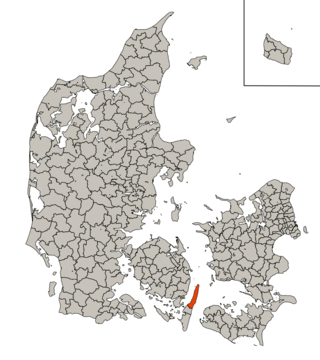
Until 1 January 2007 Tranekær Municipality was a municipality in the former Funen County, on the northern parts of the island of Langeland. It also included the island of Siø. The municipality covered an area of 107.45 km2, and had a total population of 3,439 (2006). Its last mayor was Jørgen Nielsen, a member of the Venstres political party.
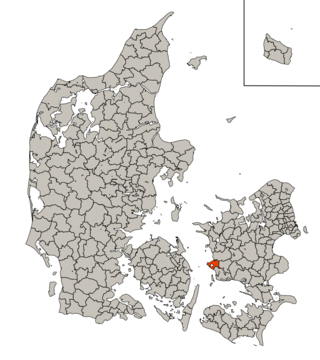
Until 1 January 2007 Korsør Municipality was a municipality in the former West Zealand County, on the southwestern coast of the island of Zealand, in eastern Denmark. The municipality covered an area of 74.25 km2, and had a total population of 20,873 (2006). Its last mayor was Flemming Erichsen, a member of the Social Democrats.

Until 1 January 2007 Skælskør Municipality was a municipality in the former West Zealand County, on the southwestern coast of the island of Zealand, in eastern Denmark. The municipality covered an area of 170.02 km2, and had a total population of 11,928 (2006). Its last mayor was Hans Ole Drost, a member of the Venstre.

The North Jutland Region, or in some official sources, the North Denmark Region, is an administrative region of Denmark established on 1 January 2007 as part of the 2007 Danish municipal reform, which abolished the traditional counties and set up five larger regions. At the same time, smaller municipalities were merged into larger units, cutting the number of municipalities from 271 before 1 January 2006, when Ærø Municipality was created, to 98. North Jutland Region has 11 municipalities. The reform diminished the power of the regional level dramatically in favor of the local level and the central government in Copenhagen.
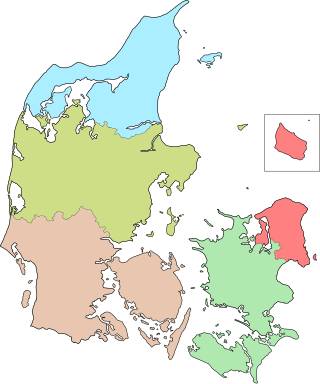
The five Regions of Denmark were created as administrative entities at a level above the municipalities and below the central government in the public sector as part of the 2007 Danish Municipal Reform, when the 13 counties (amter) were abolished. At the same time, the number of municipalities (kommuner) was cut from 270 to 98. The reform was approved and made into a law by the lawmakers in the Folketing 26 June 2005 with elections to the 98 municipalities and 5 regions being held Tuesday 15 November 2005.

Ringkøbing-Skjern Municipality is the largest municipality in Denmark. It was formed on 1 January 2007 as part of the 2007 administrative reform from the former municipalities of Egvad, Holmsland, Ringkøbing, Skjern, and Videbæk. New figures concerning Regions and Municipalities of Denmark published by the Ministry of Economics, "Municipal Key Figures", state that the new municipality from 2011 had a total area, including some water, of 1,494.56 square kilometres (577.05 sq mi), the largest municipality in Denmark by area. The total population was 56,348 with a population density of 38 per square km. It is part of Region Midtjylland, also known as the Central Denmark Region. The Mayor of the Municipality since 2018 is Hans Østergaard (Venstre).

Until January 1, 2007 Fjerritslev Municipality was a municipality in the former North Jutland County, on the North Jutlandic Island, bordering the Limfjord to the south and North Sea to the north. The municipality covered an area of 289.65 km2, and had a total population of 8,397 (2006). Its last mayor was Otto Kjær Larsen, a member of the Venstre political party.

Socken is the name used for a part of a county in Sweden. In Denmark similar areas are known as sogn, in Norway sokn or sogn and in Finland pitäjä(socken). A socken is a country-side area that was formed around a church, typically in the Middle Ages. A socken originally served as a parish. Later it also served as a civil parish or an administrative parish, and became a predecessor to today's municipalities of Sweden, Finland, Norway and Denmark. Today it is a traditional area with frozen borders, in Sweden typically identical to those of the early 20th century country-side parishes. The socken also served as a registration unit for buildings, in Sweden recently replaced by identical districts as registration unit. A socken consists of several villages and industry localities, and is typically named after the main village and the original church.
In the period preceding the Municipal Reform of 1970, Denmark was divided into around 170 hundreds. In the timeframe 1793 through 1970, each parish was functioning as a municipality within their respective hundreds. The hundreds were in turn part of a county. This was changed in 1970, when the parishes were merged into larger municipalities sometimes crossing hundred borders, and the hundreds fell out of administrative use.

Until January 1, 2007 Nyborg Municipality was a municipality in the former Funen County, on the east coast of the island of Funen, in central Denmark. The municipality covered an area of 83.57 km2, and had a total population of 19,134 (2006). Its last mayor was Jørn Terndrup, who was a member of the Venstre party.

Until January 1, 2007 Slagelse Municipality was a municipality in the former West Zealand County, on the southwestern coast of the island of Zealand, in eastern Denmark. The municipality covered an area of 192.00 km2, and had a total population of 37,141 (2006). Its last mayor was Lis Tribler, a member of the Social Democrats.

Until January 1, 2007 Pandrup Municipality was a municipality in the former North Jutland County, on the north coast of the North Jutlandic Island. The municipality covered an area of 189.67 km2, and had a total population of 10,612 (2006). Its last mayor was Flemming Jansen, a member of the Venstre political party.

Until January 1, 2007 Brovst Municipality was a municipality in the former North Jutland County, on the North Jutlandic Island, bordering the Limfjord to the south and the North Sea to the north. The municipality covered an area of 222.72 km2, and had a total population of 8,281 (2006). Its last mayor was Mogens Christian Gade, a member of the Venstre political party.


















